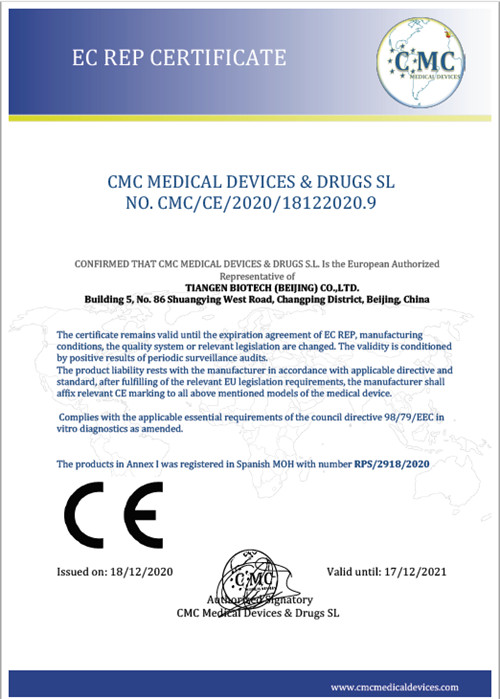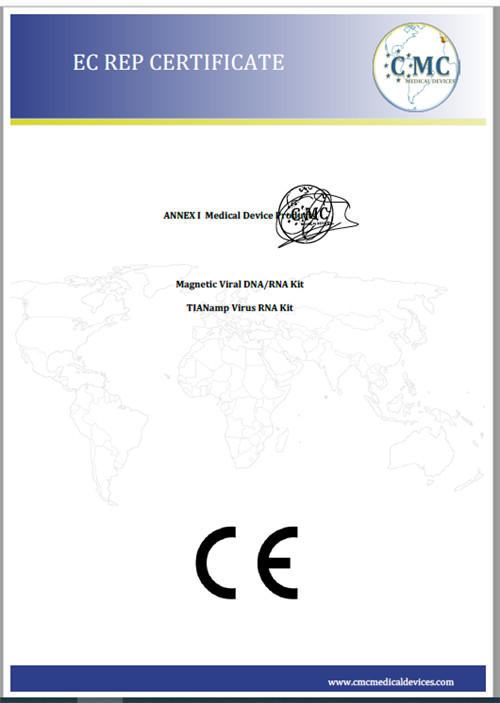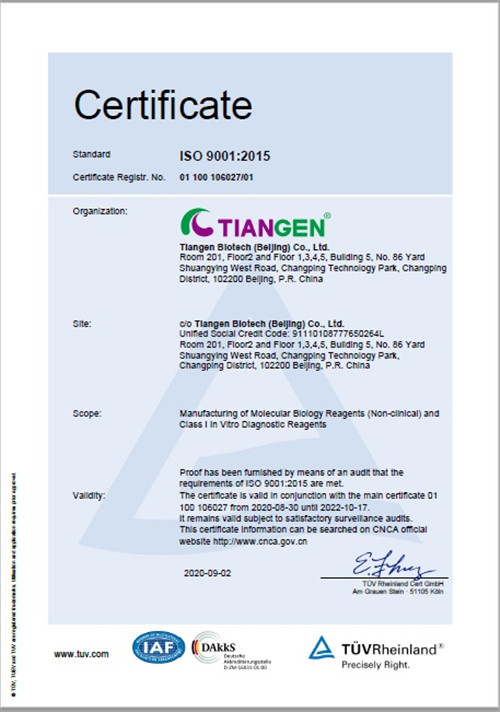Factory source Rt Reaction - 2×Taq Platinum PCR Mix – TIANGEN
Factory source Rt Reaction - 2×Taq Platinum PCR Mix – TIANGEN Detail:
Activity Definition
1 unit (U) Taq Platinum DNA Polymerase activity is defined as the amount of enzyme required to incorporate 10 nmol deoxynucleotides into acid-insoluble substances at 74°C within 30 min using activated salmon sperm DNA as template/primer.
Quality Control
The purity by SDS-PAGE detection is more than 99%; No activity of exogenous nuclease is detected; Single-copy gene in human genome could be amplified effectively; No significant activity change when stored at room temperature for one week.
Main Technical Parameters
It has 5′-3′ exonuclease activity and 3′-5′ exonuclease activity, and its fidelity is next to Pfu polymerase. The extension speed of Taq Platinum Polymerase is faster than Pfu polymerase and the amplification efficiency is higher. PCR products can be directly ligated to the blunt end or cloned with TA vector. If the cloning efficiency needs to be improved, it is recommended to purify first and add 3’-dA overhangs before cloning into TA vector.
One-tube Taq Platinum MasterMix (National High-Tech Product Certification)
■ The Taq Platinum MasterMix has improved specificity and sensitivity of PCR reaction and can amplify complex templates with high GC content, secondary structure and the like. As low as 2 copies of the target template can be amplified, ensuring more accurate experimental results.
■ The unique Taq Platinum MasterMix formula makes the whole reaction system very stable, and the activity will not be affected by repeated freeze-thaw or long-term storage at 4°C.
■ The stable and efficient pre-prepared PCR mixed solution can make the operation fast and simple, greatly reducing labor intensity and sampling error. High-performance PCR enhancer and optimizer are also included in the mix, which reduces the requirements on PCR conditions.
■ This product has both dye-containing and dye-free systems. Dye-containing MasterMix products can be directly electrophoresed after PCR, without adding loading buffer.
Applications
It can replace Pfu polymerase to amplify high fidelity products from complex templates such as genomes, and it is suitable for applications such as cloning of expression genes, site-specific mutations and analysis of single nucleotide polymorphism (SNP), etc.
Precautions in Designing PCR Primers:
The primer length is usually 20-25 mer. However, when performing long fragment PCR, the primer length should be increased to 30-35 mer.
■ There is no complementary pairing between the two primers, especially for the last 3 bases at the 3′ end.
■ GC content should be 50-60%, and avoid local rich GC or AT. In order to make primer and template bind stably, avoid AT rich structure at the 3′ end.
■ Avoid primer to form secondary structure.
■ Select two primers with Tm temperatures close to each other.
Calculation of Tm Value of Primers for PCR:
■ When the primer is less than 20 mer: Tm=2°C×(A+T)+4°C×(G+C).
■ When the primer is more than 20 mer: Tm=81.5+0.41×(GC%)-600/L, where L is the length of the primer.
■ Set the annealing temperature at (Tm-5)°C.
PCR Primer Input
The appropriate final concentration of primers can be selected between 0.1 μM and 1.0 μM. Too low a primer concentration leads to low yield of amplification products, while too high a primer concentration is more prone to non-specific amplification. Usually, when the amount of template DNA is large or complex template DNA (such as human genome DNA) is used as a template, the primer concentration should be lower. When the amount of template DNA is small or simple template DNA (e.g., plasmid DNA, etc.) is used as a template, the primer concentration should be higher.
Product detail pictures:
Related Product Guide:
We aim to find out high quality disfigurement in the generation and provide the most effective services to domestic and abroad clients wholeheartedly for Factory source Rt Reaction - 2×Taq Platinum PCR Mix – TIANGEN , The product will supply to all over the world, such as: Russia, Angola, Philadelphia, Immediate and expert after-sale service supplied by our consultant group has happy our buyers. Comprehensive Info and parameters from the merchandise will probably be sent to you for any comprehensive acknowledge. Free samples may be delivered and company check out to our corporation. n Morocco for negotiation is constantly welcome. Hope to get inquiries type you and construct a long-term co-operation partnership.
The product manager is a very hot and professional person, we have a pleasant conversation, and finally we reached a consensus agreement.
Products categories
WHY CHOOSE US
Since its establishment, our factory has been developing first world class products with adhering the principle
of quality first. Our products have gained excellent reputation in the industry and valuabletrusty among new and old customers..








